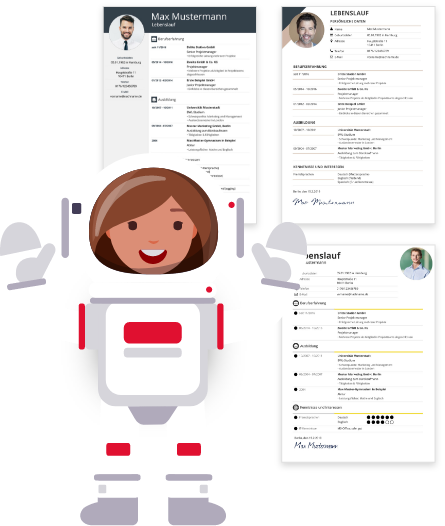
The CV provides a clear summary of your career to date and is therefore the most important document in your job application. It not only contains your personal details and provides information about your work experience, but also includes your educational background. This gives your potential employer an overview of your education as well as your knowledge and skills. Below, you can find out how to present the education section of your CV correctly and what information you should include.
The correct placement of the education section in your CV
A good CV is clearly structured and easy to read. Recruiters should be able to find the most important information at a glance. This is why the CV follows a specific order:
- Personal details
- Work experience
- Educational background
- Skills and abilities
- Hobbies / voluntary activities
Present the education section of your CV correctly
The education section should have a suitable heading – you can simply name it “Educational background” or “Education”. It contains your school education, your vocational training, and your studies. You can also divide them into three separate categories, depending on how detailed your information is.
German CVs tend to be antichronological: this means that you start with your most recent education - usually your highest educational qualification. This allows recruiters to see the most important information first.
The education section of your CV is divided into two columns. On the left-hand side, enter the period of your education. It is sufficient to name the month and year, i.e.: MM/YYYY - MM/YYYY. If you have not yet finished your current occupation, insert the starting date, followed by "- today".
In the right-hand column, enter the exact name and location of your training programme. It will look like this.
If you have a good final grade or the job requires this information, you can enter it in the right-hand column as well. Note that you should include your final grades for all stages of your education if you choose to do so - for example, your A-level average and your Bachelor's grade.
You can highlight important information in the education section of your CV by providing more detail. Add bullet points with the title of your dissertation or specific courses you've taken, for instance. Bonus points if the subjects are relevant to the job you're applying for.
For example:Are you applying for an apprenticeship as a tax consultant? In this case, your A-levels in maths and physics will be a good indication to your future manager. However, if you focused on English and literature at school, mentioning this in your educational background will probably not give you an advantage.

Choose a professional CV template to showcase your education.
TemplatesWhat information belongs in the education section of your CV
Your school, vocational and academic education are all part of your educational background. However, just like your cover letter, your CV should always be tailored to the job you are applying for. When presenting your educational background, you should keep in mind whether you already have several years of work experience or whether you are writing your first job application as a young professional.
Education section for applicants with work experience
Your work experience is the most important piece of information on your CV - after all, it is proof of your qualifications. If you have several years of work experience, you don't need to detail your education.
An employer is unlikely to be interested in the name of your primary school if you have been working for ten years. In this case, you should only list your highest level of education. If you have a Master's degree, you no longer need to mention your A-levels - after all, a university entrance qualification is a prerequisite for studying.
The education section for recent graduates
If you have no work experience, the education section will be the focus of your CV. If you are applying for an apprenticeship, degree, or internship, it is advisable to list your entire education, starting with your highest educational qualification.
The educational section for career changers
Applying for a job as a career changer is difficult: you have to prove that you are qualified for a position for which you have not been trained. You should therefore carefully consider which stages of your education are relevant to the job you are applying for.
For example, a university degree indicates good self-organisation and resilience, while an apprenticeship indicates practical work experience. Your educational background therefore highlights your abilities and soft skills, even if the subject you studied does not necessarily match the job you want.
But even as a career changer, your work experience is usually more important. So think carefully about which stages of your education you really want to highlight, as there is only so much space on your CV.
Gaps and lies in the education section
Dropping out of school or quitting an apprenticeship is probably something you’d rather hide - but you should still include it in the education section of your CV. Lying in your job application or omitting information is never a good idea: such gaps will always come to light during a job interview.
However, there are ways to present these unsightly details in a more positive way. "Studied without a degree" sounds better than the phrase "dropped out". You can also use the term "jobseeker" to describe temporary unemployment.
Small gaps and career changes are no longer a disadvantage when applying for a job. You will usually have the opportunity to explain yourself in an interview. Talking openly about your reasons for changing your course or why you decided to end your apprenticeship makes you look confident. It shows that you are not afraid to make difficult decisions. People are more likely to remember your honesty than your decision to quit your apprenticeship.
